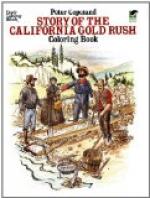And one day they said joyfully to each other, “We are in California at last;” and it was a happy company that travelled down through the pines of the mountain sides and the oak trees of the foot-hills. Many emigrants left the train when they got to the great Sacramento River valley, and settled here and there to farming. Polly’s father with others kept on to the gold-diggings and camped there. He built a log-cabin soon, for it was almost winter and time for the rains, and Polly says she was glad to have a house at last. They finally took up farming land near what is now Stockton, as gold-mining did not pay.
Mrs. Davis, who is straight and strong, and still a hard worker, says her five months’ trip across the plains was almost like a long picnic after all, for she has forgotten many of the trying and disagreeable things.
THE BUILDING OF THE OVERLAND RAILROAD
The army of emigrants and gold-hunters who crossed the plains to California found it was a long and tiresome trip by wagon-train or on horseback. The oxen or mules would sometimes get so tired that they could go no farther; and because the food often ran short, there was much suffering from hunger.
The longest way of all to California was by sailing vessel from New York round Cape Horn, nearly nineteen thousand miles to San Francisco. The passengers paid high prices and were six months on the way. Those who came by the Panama route had trouble crossing the isthmus, where it was so hot and unhealthy that many died of fevers and cholera. The Pacific mail steamers connecting with a railroad across the isthmus at last shortened the time of this trip of six thousand miles to twenty-five days. For ten years all the Eastern mail came this way twice a month.
It was thought a wonderful thing when the “pony express” carried mail twice a week between St. Joseph, Missouri, where the Eastern railroads ended, and Sacramento. To do this a rider, with the mail-bag slung over his shoulder, rode a horse twenty-four miles to the next station, where a fresh pony was ready. Hardly waiting to eat or sleep, the rider galloped on again. Five dollars was often charged at that time to bring the letter railroads carry now for two cents.
So you will see that a railroad to join California to the Eastern states was a great necessity and had often been talked of. Several ways to bring the iron horse puffing across the plains and up the mountains with his long train of cars had been laid out on paper. The emigrants had found that the best highway from the Missouri River to California was to keep along the Platte River in Nebraska to Fort Laramie and the South Pass of the Rocky Mountains, then by Salt Lake, and along the Humboldt and Truckee rivers, crossing the Sierras at Donner Pass. Other roads were talked of, and Senator Benton of Missouri favored a nearly straight line between St. Louis and San Francisco.




